West Texas bermudagrass lawn needs help!
I'm attaching some pictures of my lawn, which is looking pretty awful lately. For the last several years, I've been paying a guy to take care of it, but I recently fired him and decided to take over myself.
In the last couple of weeks, I've done the following:
- Increased watering to 25 minutes 3x per week
- Replaced some sprinkler nozzles to improve coverage and repair damaged ones
- Aerated
- Applied Spectracide, since grubs are a common problem in this area
- Tested the soil with a home kit - pH is 7-8, N "low", P "med", and K "high" (we live in a desert region, and the soil is mostly sand from what I can tell)
- Applied Scott's Southern Turf builder (this morning actually) according to package instructions
- Spent a lot of time staring at it and wondering what else to do!
I recently found and read the Bermuda Bible, and will apply the maintenance routine suggested there. I'm not sure what to do about watering, since I don't know if all the brown grass needs more water or if I have some other problem.
If there are any suggestions for other things I can do to improve this lawn, I'd be most grateful!
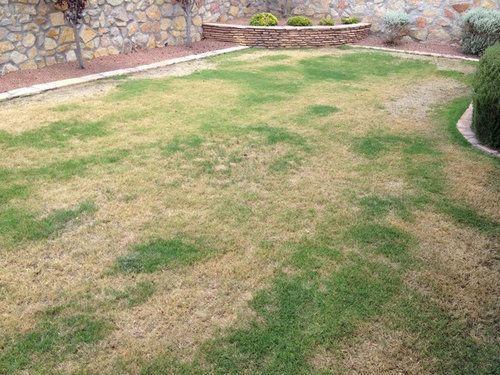
Comments (64)
dchall_san_antonio
11 years agoIs there any chance you were sabotaged by your ex lawn guy? It wouldn't have to be something like RoundUp. Just applying the wrong herbicide in the heat would cause that damage. Or, like I mentioned before, fertilizer without watering it in would damage the lawn.
nearandwest
11 years agoI too, was wondering if the lawn guy may have applied something harmful to the turf.
Related Professionals
Jennings Landscape Architects & Landscape Designers · Arlington Landscape Contractors · Alpharetta Landscape Contractors · Bridgeport Landscape Contractors · Davidson Landscape Contractors · Deerfield Landscape Contractors · Ellicott City Landscape Contractors · Kaysville Landscape Contractors · Longview Landscape Contractors · Maywood Landscape Contractors · Medford Landscape Contractors · New Carrollton Landscape Contractors · San Pablo Landscape Contractors · Apple Valley Swimming Pool Builders · Tampa Swimming Pool Buildersapundt-tx
11 years agoDid he know he was getting fired before he came to your house to take care if the lawn?
texas_weed
11 years agoHow large of a lawn are we talking about? You got some time left for rehab, but I need to know how large of a lawn it is before I say anything.
erict43
Original Author11 years agoIf the ex-lawn guy had anything to do with it, I'm sure it was accidental. I let him go after the lawn went south and he didn't seem to know what to do about it. It was amicable, I just told him I was going to start taking care of it myself.
It's a small yard...we have tiny lots in El Paso. 650 sq ft of grass in the back yard and about 100 in the front.
texas_weed
11 years agoIt's a small yard...we have tiny lots in El Paso. 650 sq ft of grass in the back yard and about 100 in the front.
Perfect. In the dead zone take a garden rake, the kind with solid stiff tines and rake up the dead debris and loosen up the soil. Go to the garden center and get yourself about 3/4 cubic yard of compost, and a bag of fertilizer made of slow release urea (sulfur coated) or Ammonia Sulphate based. Spread the compost evenly over the whole yard being careful not to bury any of the grass, and rake it in the dead zone area to mix with the loosened soil. Apply the fertilizer at the recommended bag rate.
The next challenge and this is the crucial one, water. You have really crappy soil in El Paso. In fact it is not soil, it is coarse sand if memory serves me correctly. So you can throw out all watering rules because they do not apply to you. If you water only once a week your grass is going to die. Sand does not hold water or nutrients worth a darn.
You need to know how to let the grass tell you when it needs soaked by watching for the color shift. But for now in this heat you will likely need to water everyday or every other day.
To combat the soil PH and nitrogen level you need to use a sulfur coated urea or ammonia sulphate fertilizer. The sulfur in these products will lower the PH. You will also need to fertilize more frequently. I suggest every 2-weeks at half the recommended rate.
erict43
Original Author11 years agoThanks, TW, I I will follow your advice. You are right, the soil is pretty much all sand. By following your suggestions, the good grass should eventually spread into the dead areas, correct?
The city ordinance says that I can water on Tuesday, Thursday, and Saturday, which is what I have been doing. With the sandy soil, would I be better off watering twice a day for half the time, or giving it a longer watering in the morning as I have been?
Thanks!
texas_weed
11 years agoTW,
SO what caused this? bad soil.Beats me. If I had to guess just really coarse dry nutrient poor soil.
texas_weed
11 years agoBy following your suggestions, the good grass should eventually spread into the dead areas, correct?
That is the plan.
The city ordinance says that I can water on Tuesday, Thursday, and Saturday, which is what I have been doing. With the sandy soil, would I be better off watering twice a day for half the time, or giving it a longer watering in the morning as I have been?
For now early in the morning, and again during late day. Monitor soil moisture with a Screw Driver test. Look for wilting during the heat of the day. On off days can you use hand spraying?
dchall_san_antonio
11 years agoI spent the occasional night at Fort Bliss during the 70s and remember the soil as being worse than TW described it. Yes, the soil watering mantra does not apply in a coarse, river bottom, rubble. That truly is not soil. In fact El Paso might be my new 'worst spot in the nation' for soils dethroning Las Vegas.
Has this year been hotter or dryer than normal?
erict43
Original Author11 years agoTW, I can probably do some hand spraying, or maybe run the sprinkler after dark on off-days. That would most likely be restricted to the back so I don't get a citation.
dchall, El Paso is probably not much different from Las Vegas, the general terrain and climate is similar. Sand and rocks. It has been drier than normal the last couple of years. And we had a week of 105+ temperatures in June, so I'd say it's been hotter than usual too.
dchall_san_antonio
11 years agoWith that in mind, I'm going with heat stress. Situation normal for the conditions. Water very briefly in the afternoons if you can to cool the grass off. This is not so much a watering, but a refreshing rinse.
erict43
Original Author11 years agoRegarding the fertilizer, the Lowe's near me has Howard Johnson's 21-0-0 fertilizer. I'm not familiar with the brand, but the label on the back says:
21% Ammoniacal Nitrogen
24% Combined Sulfur
Derived from: Ammonium SulfateIs this what I should be using? If so, I'll pick up a bag of this stuff, and around 18 bags of compost, and get started...

apundt-tx
11 years agoTrying to figure out how much of this is fast release nitrogen.
I tried to look up HJ 21-0-0 on the internet and the HJ site. No luck.
Is there anything on the back of the bag about water-soluble or Water-insoluble.For some reason I am getting hits on the internet about ammonium nitrate being fast release.
The sulfur coated urea or ammonia sulphate fertilizer that TW suggested is a slow release and wont burn your yard up.
david_tx
11 years agoEric, my lawn looks much like yours and I, too, am baffled. Question, do you see a bunch of small holes in the dead areas?
erict43
Original Author11 years agoapundt,
I also had a very hard time finding any information about this product. I didn't really see anything on the bag about slow release or quick release. Before I make a purchase, I'll print out TW's reply to me and take it to the local nursery where the employees know what they're talking about, and see if they can recommend something appropriate.david,
I have not noticed any small holes in my dead areas, just the ones I made with my aerating tool. I'm no expert, but if I did see that, I would suspect insects of some kind. Maybe if you start a thread on that and post some pictures, someone would know what it might be.apundt-tx
11 years agoIf you can't find a slow release fertilizer maybe do that 21-0-0 and 1/3 rate. It would be like putting down a 7-0-0 and not burn the grass up.
erict43
Original Author11 years agoI just got a response from the vendor:
"Good Morning Eric,
21-00-00 is Ammonium Sulfate and it does not contain any slow release nitrogen.
Thank you for your interest in HJE products.
Thanks,
Pam"texas_weed
11 years ago21-00-00 is Ammonium Sulfate and it does not contain any slow release nitrogen.
Do not use it, especially now as it is way to hot and dry.
erict43
Original Author11 years agoTW, do you still recommend adding a slow-release fertilizer (I saw your advisory post about not fertilizing), or should I just go with the compost?
texas_weed
11 years agoPut the compost down, and hold off a while on fertilizer till it cools off a bit. If your new watering routine starts greening the grass up and growing well, then you can apply fertilizer. Just use 1/2 to 1/3 rates until it cools off. But you do not want to push it too hard right now, it is just too dang hot. Once the daytime temps drop back off in the 90's you can get aggressive.
texas_weed
11 years agoOne problem I notice though, is that the compost has a lot of large "particles" in it, pieces of wood and so forth,
Well sorry my fault I should have said SCREENED COMPOST. Too late now. For now raise the cutting height up until you start seeing big improvement. This will help conserve water. It maybe next season before you can go low again. Right now you are in rehab mode, so do not push too hard.
Once you start seeing some good growth and the weather cools a bit hit it with fertilizer. One step at a time. Me thinks by the end of the growing season you will be proud. Next season you will be the envy of the neighborhood.
Keep in mind compost is just a temporary thing and will all be gone in a year or less as it decomposes. Shop around and see if you can find PEAT, not Peat Moss but PEAT and use it to top dress with every few months. Peat really holds the water and is already decomposed OM so it stays around and will build up tilth to the sand and help it hold water and nutrients.
erict43
Original Author11 years agoHi guys, just wanted to post a photo showing progress so far.
The green areas are looking better and better, the brown areas are starting to turn green, and the dead areas now have little shoots popping up here and there. Thanks to your help, I am optimistic about this.

erict43
Original Author9 years agoI have been meaning to come back and do that, thanks for reminding me.
The advice rendered by texas-weed has worked the trick. My grass looked great last season and continues to look great this year as well.
I water twice a day for 10-min max each time - I got one of those fancy irrigation controllers that reduces water depending on weather conditions. I fertilize every 2-3 weeks at half the rate with ammonium sulfide fertilizer, and keep it cut short. I have to cut twice a week at times, but it's a small yard so I don't really mind. Keeping it short in the sun and heat we have here helps keep weeds under control and kills off any other grass species that try to infiltrate my lawn. Not to mention that it looks nice! I have not had to use any kind of weed control whatsoever. I put insecticide once or twice a year to keep the grubs away.
All in all, once I learned how to do it properly, it's been rather easy to maintain the lawn, and my neighbors are all envious. I'll post a photo later tonight.
Thank you all for the great help!
dchall_san_antonio
9 years agoI would like to point out with emphasis that watering 2x per day ONLY APPLIES TO A LIMITED PART OF THE WORLD. That area begins at about Junction, Texas, and extends to Yuma and up to Las Vegas to Green River, Utah. Many parts of that range still do very well watering once per week, but if you have coarse gravelly soil, you need to water more frequently.
Can't wait to see the pix!!
erict43
Original Author9 years agoTrue, we have sandy soil that can't hold on to water for very long, so it needs to be applied more frequently. The same is true of the fertilizer, which is why frequency is increased and quantity is decreased.
Here's a photo of my beautiful turf!

dchall_san_antonio
9 years agoLooks great...today. The shade from those trees is gonna be trouble for you, though.
Joyful Texas
8 years agohi! I live in El Paso, too! What compost did you purchase from Lowes of Home Depot? The one I got yesterday has lots of wood sticks, etc. Your turf looks great!
dchall_san_antonio
8 years agoHey Sook. While it's nice to reread the occasional historical post from top to bottom, I'm afraid we might not be hearing back from erict43 on this. Houzz does seem good at sending emails to everyone on these posts, so maybe he'll respond.
Why don't you start a new topic. Start by reminding us where you live, then explain what you're looking at in your yard, what kind of grass you have, and whether there is any shade that might be a problem. Also we're interested in your watering schedule - how frequently you water and for how long.
Compost is not normally needed in a lawn, but for your area it can be beneficial. You might try Desert Rock Company on Plant road between Loop 375 and the river (I know...where???). It's there. They might have choices in compost. You want something sifted through a 1/4-inch screen if you can get it. You'll pay more for that, but it's better stuff. Be sure to stick your hands deep into the compost pile, bring out a double handful, and smell it. It should smell like incredibly fresh soil. If it smells like manure, sour, rank, dank, musty, moldy, or anything that isn't fresh, it's not finished "cooking" yet. You can still buy it but let it sit before you use it. Oh and it should be 'room temperature' and no hotter. So no hotter than 100 degrees. If it is hotter than the air that means it's still full of relatively fresh stuff and will be ready soon.
Hope this helps.erict43
Original Author8 years agoI'm late to reply, but I am still around!
Sook, I picked up something called "composted manure". All of the compost I've come across from Lowe's has lots of sticks, as you mentioned. What I did the last time was buy a roll of wire screen with 1/4" spacing between the wires, just like dchall suggested. I made a sieve with it by stapling it to a wood frame. Pour the compost into it and shake, so that the smaller pieces pass through and the big chunks of wood stay in the screen. Then I spread out the stuff that fell through.
It's time-consuming, and to be honest, I'm not sure how much improvement I am getting from the compost. But I'll continue to do this on a yearly basis. I also try to cut my grass often without using the grass catcher, to add the chopped grass back into the soil. I figure we need all the organic matter we can get, and it seems a shame to throw the grass clipping away.
dchall_san_antonio
8 years agoThe whole point of compost (or composted manure) is to wash the microbes off the compost and into the soil. The compost itself is depleted of almost all NPK value. To put it into perspective it takes 700 pounds of compost to get the same fertilizer value as 15 pounds of any other organic fertilizer. But you can get microbes off of compost that do not exist on the fertilizer. So compost has its place.
Do y'all still have a lot of feed lots in the El Paso area? I just drove through there a few weeks ago and don't remember seeing any? Then again my head was in the cockpit - I was having car trouble at the time (just filled with gas but the gage was showing flat empty). Anyway, if you have feed lots, compost ought to be very reasonably priced. Compost is made by allowing manure and other organic stuff to decompose for 6 months to a year. As the microbes decompose the raw manure it converts it into a very fresh smelling, and safe, mulchy sort of material. If it seems warm or stinky when you look at it, then it isn't finished 'cooking' yet. They are selling it early. You can still buy it but I would not use it until it is finished off. Your nose is the best way to tell when it's ready.
Joyful Texas
8 years agolast modified: 8 years agoThank you everyone for replying. I have attached photos of my yard. I have just moved to El Paso from Dallas area 6 months ago, and I am pretty new to lawn care and gardening. We have installed our lawn at the end of March this year - this is newly constructed area. I water it three times a week. (Tues, Thurs, Sat) My sprinkler system goes half an hour for half the grass and half an hour for the other half each of the watering days.
The grass looked really bad about two months ago. We were gone for one week for a holiday. When we came back, it looked as if the grass was dying. We also had a lot of spotted spurge looking weeds. I pulled them all out and sprayed Weed b gon. They look like these. http://aggie-horticulture.tamu.edu/galveston/Weeds/1200_x_800-JPGs/137-Fig_1--Spotted_Spurge-GCMGA5200.jpg I think they are almost gone, but my next door neighbors have a lot of it, so I am sure their seeds will fly over soon.
Thanks to your help, after reading this post, my yard got better. I sprayed Spectracide (birds did come each morning for grubs, but no more birds!) and weed and feed fertilizer. Also, I put down compost (even though it had a lot of wood chips, but it was cheap - $2 a bag from Lowe's), and it became greener a bit, just like the photos. However, my backdoor neighbor hires someone to take care of the lawn, and it is ever so green. I was wondering what the secret is. My grass is not so dense, and uneven... if you know what I mean.... What else shall I do to make it a beautiful lawn? Any suggestions? (Oh, my dog does not dig nor pee on the grass that much. She is trained to do it on rocks on the side of my house.)
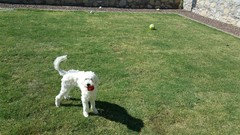
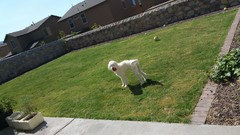
erict43
Original Author8 years agoSook,
Technically it is against the rules in El Paso, but I would suggest watering every day for half as much time. The sandy soil here doesn't hold on to moisture very well, so deep watering doesn't help very much. When the weather cools down, you can decrease the watering, because the grass will hibernate anyway.
It's probably too late in the season to see a big improvement this year, but all the good things you do will pay back in time. When I originally posted about my problem, I got some improvement, but it wasn't until the next summer that the grass really started looking nice.
The yellowish areas might be where the grass was cut too short, compared to the surrounding areas. I get that effect too if I wait too long between mowings. You might consider raising your mower height one notch and cutting more frequently. The rule of thumb is to not cut more than 1/3 of the length of the grass at one time.
dchall,
There are some feed lots between El Paso and Las Cruces, so you're probably right about the compost, but I imagine one would have to go to one of the independent garden centers to find it. I'm lazy so I usually just go to the Lowe's that's close to me :)
reeljake
8 years agoOur Lowes around Houston carry "Black Kow" compost & I've found it to be pretty clean stuff. Not as good as local poo merchants might offer, but who can complain when it comes in nice clean bags & they load it in the truck for you for like $2/bag?
dchall_san_antonio
8 years agoReeljake, if you have some Black Kow in your garage right now, could you run a quick test for me? Do a jar test on it. Drop a cup of it into 2 cups of water and tell me how much sand you get. I suspect they "spike" the product with sand to bring up the weight and fill the bag. I want to be proved wrong, though, because I like that product for small compost needs.
reeljake
8 years agoI don't have any in the garage right now, but I can buy a bag in the next few days & do such a test, sure. Got me curious now too.
michtx
8 years agoHi erict43,
I'm in Central Texas on a bluff top with very little top soil, The hydromulched Bermuda grass is 2 years old. This season, I based my watering and mowing on your results and am happy with the progress the grass made. Thank you for sharing and wondered if you could respond with your winter watering schedule. Thanks for any info.
dchall_san_antonio
8 years agoHi Mitch, do you mind starting a new thread so we don't have to read through all of the previous ones to catch up and find that you really have a new topic? If you have before and after pictures that would be great. Also, where in Central Texas?
michtx
8 years agoerict43 said "When I originally posted about my problem, I got some improvement, but it wasn't until the next summer that the grass really started looking nice." I am asking how he watered the winter between ...... same topic ; ). Sorry, wish I had photos to post.
dchall_san_antonio
8 years agoWhen temps are below 70 degrees F, then deep watering once a month is all you need. Deep means 1 inch all at one time. Rain counts, and we might have a wet winter with this El Nino I keep reading about. Even with dormant grass, the cool weather soil microbes need moisture to do what they do all winter.
Turf Doctor
8 years agoI'm going to go ahead and resurrect this old post so hopefully someone can learn and hear from a different perspective from a professional. I would first like to mention, TexasWeed, I know who you are, I've read many of your post, and you have some knowledge. With all due respect, I respectively disagree with you in many aspects though. One of the paint points I disagree with you on, is you suggesting a SLOW RELEASE FERTILIZER in the original posters situation. While slow release fertilizers can be great in many areas, and especially in particular times of the year. This was not a great suggestion for the poster in my honest and fair opinion. Why? The poster is growing a lawn on sand. We know what that means. Lower CEC levels, and little nutrient holding power. Nutrients will never last as long in Sand. The same PPSCU, XCU, and Sulfur coated fertilizers that may claim 2-3 months, is not near the case for turf growing on Sand. Even for lawns growing on Clay such as myself here in Central Texas, many people fail to understand how "Slow Release" products work. Knowing the growth characteristics will put you far ahead of the game. Many PPSCU and various other slow release products contain coatings which are dependent on various factors. If you study these factors, most of these coatings are designed to be broken down with the main factor being "TEMPERATURE." Slow to release nutrients when cool, and they literally dump nutrients when soil temperatures are very warm. In Texas, this is the majority of the time, so what you get left with, is an over-priced bag of "Slow Release" that's dumping much quicker then "SLOW" due to high temperatures being exhibited. My approach, especially on dealing with "SAND" such as the poster is SPOON FEEDING quick release fertilizers. Bermuda especially, needs to be supplied adequate nitrogen for outstanding turf quality, density, and color. The goal is to feed the turf what it needs as it uses it. By doing so, the turf will continue to be fed, and the sandy soils that don't hold nutrients will continue to be ideal for the turf.
The original poster had great improvements from doing 1/2 applications from Ammonia Sulfate every few weeks and this supports exactly what I'm saying. However, to the original poster, you are forgetting many important nutrients. A soil test will be MANDATORY for the perfect lawn. Without a soil test, I can't recommend phosphorus, I see enough of it around my parts of Texas. The problem is much of the phosphorus isn't available. Same with Potassium, except I consider this CRUCIAL. Your lawn needs potassium to aid in extreme temperatures and disease pressure such as what we have here in Texas. Potassium is a luxury consumption nutrient, meaning you put it down, the turf is going to use it, if in available form. Much of our potassium in our soils is NOT AVAILABLE when comparing from my recent soil test, to actual TISSUE TEST. Also, using 21-0-0 provides lots of Sulfur that will aid in bringing Texas's natural high pH down and will also aid in uptake up other nutrients, including our long lost Iron. If you've ever applied Iron in Texas, you'll notice, there might or might not be a response, if you get a response, it doesn't last. This is pH related and calls for using only CHLEATED IRON products which is much more usable and available to the turf in our area.
If you want a usable mix, trust my word on this, try it, and come back to me and tell me you have the best lawn in the neighborhood after half a growing season. (You might have to source these products), but they are all available in Texas. Depending on your work schedule and free time you can adjust your rates and applications, but you need to apply in adequate water to avoid burn potential. Most likely, you will have to go with the lower spray rates and more often unless you have a high volume sprayer like we use that holds hundreds of gallons.
Bermuda:
Weekly Fertilizer Mix:.25N per 1,000 Sq. Feet (From Ammonia Sulfate 21-0-0)
.25 (SOP) per 1,000 Sq. Feet (Potassium Sulfate)
.50 ounces per 1,000 Sq. Feet (Micro nutrients with chleated Iron and mg and mn.
The micro nutrient product is really important and will aid in giving your turf the color you are looking for. I (HIGHLY) suggest either using (FeATURE 6-0-0) by loveland products or Main Event Chleated Micro nutrients
If you don't have the time to spoon feed your lawn weekly, you can adjust the rates, either double for bi-weekly, or multiply x 4 for monthly. Don't go longer then month long applications. The only catch is, 21-0-0 has burn potential. You will need at (MINIMUM) of 1 gallon of water per 8 ounces of 21-0-0 in your mix to avoid burn potential.
Do not adjust the rates above, this mix is tried and true on Texas Turf and will leave you with the greenest lawn in the neighborhood. If you don't have a large enough sprayer with capability of putting out enough water volume, you're better sticking with granular fertilizers. We use 200+ gallon tanks, with walking booms for an even application. Nozzles on the sprayer are also important. We use TeeJet Air Induction and FloodJet tips to reduce drift, depending on the water needed for the application.Joyful Texas
7 years agolast modified: 7 years agoI now have some rye grass growing on my Bermuda. What shall I do? I did put compost down as suggested by Eric43, and growing pretty nicely (Thank you for your suggestion!). However, I do see some dark shaded grass growing here and there. I have a neighbor that has overseeded theirs with rye. I hand picked about 2 gallon containerful yesterday, but it took forever. Is there any other way? I chatted with Scotts livechat, and they told me to spot treat with Round up. Do you think that's the only option? Thanks for everything!
dchall_san_antonio
7 years agoKilling one grass in the middle of other grass, without hurting the other grass, is very difficult. Spot treating with RU is one alternative. The bermuda will come back. There is a spray/foam version of RU that really limits overspray onto the surrounding grass.


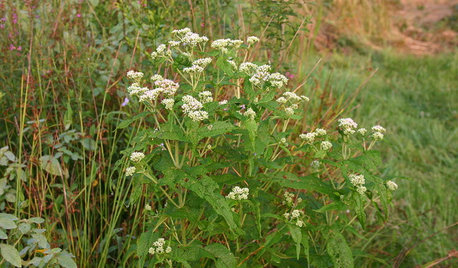
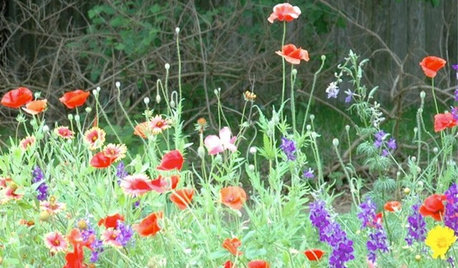




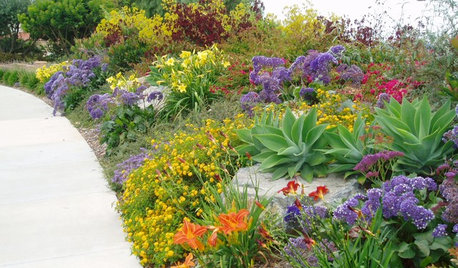









erict43Original Author